Transitional dendritic cells are distinct from conventional DC2 precursors and mediate proinflammatory antiviral responses
- PMID: 37414907
- PMCID: PMC10683792
- DOI: 10.1038/s41590-023-01545-7
Transitional dendritic cells are distinct from conventional DC2 precursors and mediate proinflammatory antiviral responses
Abstract
High-dimensional approaches have revealed heterogeneity amongst dendritic cells (DCs), including a population of transitional DCs (tDCs) in mice and humans. However, the origin and relationship of tDCs to other DC subsets has been unclear. Here we show that tDCs are distinct from other well-characterized DCs and conventional DC precursors (pre-cDCs). We demonstrate that tDCs originate from bone marrow progenitors shared with plasmacytoid DCs (pDCs). In the periphery, tDCs contribute to the pool of ESAM+ type 2 DCs (DC2s), and these DC2s have pDC-related developmental features. Different from pre-cDCs, tDCs have less turnover, capture antigen, respond to stimuli and activate antigen-specific naïve T cells, all characteristics of differentiated DCs. Different from pDCs, viral sensing by tDCs results in IL-1β secretion and fatal immune pathology in a murine coronavirus model. Our findings suggest that tDCs are a distinct pDC-related subset with a DC2 differentiation potential and unique proinflammatory function during viral infections.
© 2023. The Author(s), under exclusive licence to Springer Nature America, Inc.
Figures

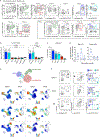


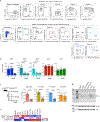


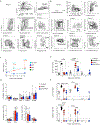




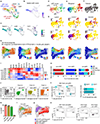
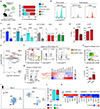
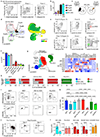



Comment in
-
tDCs - a distinct subset with dual functional and developmental roles.Nat Immunol. 2023 Aug;24(8):1222-1223. doi: 10.1038/s41590-023-01565-3. Nat Immunol. 2023. PMID: 37443285 No abstract available.
Similar articles
-
What Makes a pDC: Recent Advances in Understanding Plasmacytoid DC Development and Heterogeneity.Front Immunol. 2019 May 29;10:1222. doi: 10.3389/fimmu.2019.01222. eCollection 2019. Front Immunol. 2019. PMID: 31191558 Free PMC article. Review.
-
Flt3 ligand-generated murine plasmacytoid and conventional dendritic cells differ in their capacity to prime naive CD8 T cells and to generate memory cells in vivo.J Immunol. 2005 Jul 1;175(1):189-95. doi: 10.4049/jimmunol.175.1.189. J Immunol. 2005. PMID: 15972647
-
Dendritic cell type 3 arises from Ly6C+ monocyte-dendritic cell progenitors.Immunity. 2023 Aug 8;56(8):1761-1777.e6. doi: 10.1016/j.immuni.2023.07.001. Epub 2023 Jul 27. Immunity. 2023. PMID: 37506694
-
Clonal lineage tracing reveals shared origin of conventional and plasmacytoid dendritic cells.Immunity. 2022 Mar 8;55(3):405-422.e11. doi: 10.1016/j.immuni.2022.01.016. Epub 2022 Feb 17. Immunity. 2022. PMID: 35180378 Free PMC article.
-
Development of dendritic cell system.Cell Mol Immunol. 2004 Apr;1(2):112-8. Cell Mol Immunol. 2004. PMID: 16212897 Review.
Cited by
-
Rewriting the dendritic cell code in cancer-from subset identity to immunotherapeutic design.FEBS Lett. 2025 Jul;599(14):2060-2083. doi: 10.1002/1873-3468.70108. Epub 2025 Jul 16. FEBS Lett. 2025. PMID: 40667699 Free PMC article. Review.
-
The current role of dendritic cells in the progression and treatment of colorectal cancer.Cancer Biol Med. 2024 Aug 22;21(9):769-83. doi: 10.20892/j.issn.2095-3941.2024.0188. Cancer Biol Med. 2024. PMID: 39177125 Free PMC article. Review.
-
Extracorporeal photopheresis reduces the T cell stimulatory capacity of human primary blood conventional dendritic cells type 1.Front Immunol. 2025 Aug 13;16:1646421. doi: 10.3389/fimmu.2025.1646421. eCollection 2025. Front Immunol. 2025. PMID: 40881697 Free PMC article.
-
Seeing or believing in hyperplexed spatial proteomics via antibodies: New and old biases for an image-based technology.Biol Imaging. 2024 Oct 23;4:e10. doi: 10.1017/S2633903X24000138. eCollection 2024. Biol Imaging. 2024. PMID: 39464237 Free PMC article.
-
Cohesin-mediated chromatin remodeling controls the differentiation and function of conventional dendritic cells.bioRxiv [Preprint]. 2024 Oct 30:2024.09.18.613709. doi: 10.1101/2024.09.18.613709. bioRxiv. 2024. PMID: 39345451 Free PMC article. Preprint.
References
METHODS-ONLY REFERENCES
-
- Persson EK et al. IRF4 Transcription-Factor-Dependent CD103+CD11b+ Dendritic Cells Drive Mucosal T Helper 17 Cell Differentiation. Immunity 38, 958–969 (2013). - PubMed
Publication types
MeSH terms
Substances
Grants and funding
- U19 AI128949/AI/NIAID NIH HHS/United States
- AI158808/AI/NIAID NIH HHS/United States
- KL2TR003143/TR/NCATS NIH HHS/United States
- CA232666/CA/NCI NIH HHS/United States
- R21 AI147501/AI/NIAID NIH HHS/United States
- F32 CA232666/CA/NCI NIH HHS/United States
- AI072571/AI/NIAID NIH HHS/United States
- AI128949/AI/NIAID NIH HHS/United States
- R01 AI072571/AI/NIAID NIH HHS/United States
- S10 OD016318/OD/NIH HHS/United States
- KL2 TR003143/TR/NCATS NIH HHS/United States
- R37 AI072571/AI/NIAID NIH HHS/United States
- R21 AI163775/AI/NIAID NIH HHS/United States
- R01 AI158808/AI/NIAID NIH HHS/United States
- T32 AI007290/AI/NIAID NIH HHS/United States
- AI163775/AI/NIAID NIH HHS/United States
- AI147501/AI/NIAID NIH HHS/United States
LinkOut - more resources
Full Text Sources
Molecular Biology Databases

